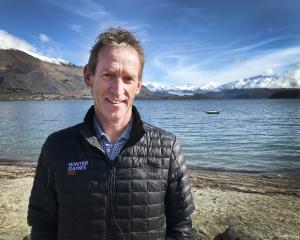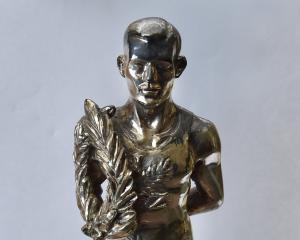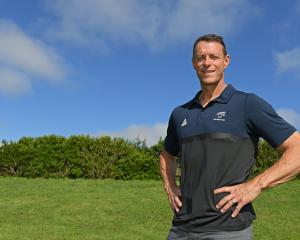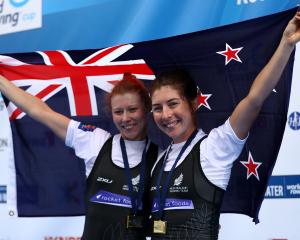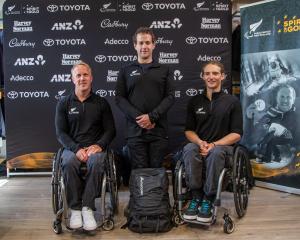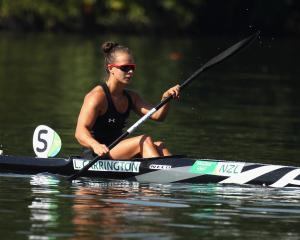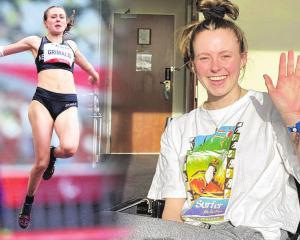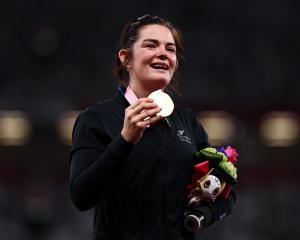Six months ago, Olympic hopeful Nicky Samuels (28), of Wanaka, took a calculated risk to take a quick break in her triathlon programme and return to New Zealand for heart surgery to correct arrhythmia. It didn't work. Now, as the clock ticks down to the final Olympic qualifying race in Sydney next April, Samuels is lining up for more surgery. Marjorie Cook reports.
Courses and conditions vary in standard-distance triathlon and drafting is permitted, so while time is important, position in the field is more important.
But, as Samuels has increasingly discovered this year, how she feels is most important.
Three minutes was all Samuels needed to foot it with ITU London World Championship race winner Helen Jenkins, of Britain, in August 2011.
Jenkins won the race in 2hr 34sec and Samuels, who needed a top-10 place to qualify for the Olympics, was 3min behind and a distant 40th.
Samuels was still recovering from the effects of a flu she caught on a flight back to the Europe after surgery to correct an irregular heartbeat in Auckland.
She readily concedes the timing, just two weeks before the London race, wasn't great "but if you don't take the risks, you don't get anywhere".
Samuels and several other New Zealand triathletes have one more chance to qualify for the Olympics.
They need a top-10 finish in the ITU Sydney World Championship race in April.
Failing that, it is up to Triathlon New Zealand officials to assess the triathletes on recent race performances and submit nominations to the New Zealand Olympic Committee for consideration.
Samuels has been a familiar sight around Wanaka since mid-September, tearing up the tarmac on her bicycle and churning out lengths at the 25m community pool.
In mid-November, she competed in the ITU World Cup race in Auckland, on the back of a victory in the first race in the Contact Cup series in Rotorua.
After a year battling blurred vision and wobbly limbs at 100% exertion, Samuels had been hoping for a trouble-free test of her "new heart", but finished a disappointing 33rd.
"It didn't work," Samuels said, in a recent interview.
"I was given an 80% chance of success. Now I am trying to go on the public list [for more surgery]. In Auckland, it happened when I ran up the ramp after the swim. It is quite often related to changes in body position and blood pressure ...
So that's the big challenge, to get that done early enough so I can get enough training in for Sydney," Samuels said.
Irregular heart problems do plague amateur and professional athletes and many choose to just slow down till they feel better.
Others, including Samuels' coach, Mark Elliott, and her early mentor, Samantha Warriner, have had the procedure done.
Triathlon New Zealand medical director Judith May, of Tauranga, has described the condition as a "common problem in an uncommon person". Samuels had a structurally normal heart that had not been damaged by intensive endurance training, she said.
Samuels has a ventricular irregularity, which she understands is "harder to get rid of" than an irregularity in the atrium.
Normally, the fainting feeling emerges in transition from bike to run. The Auckland race was the first time she'd felt it during the swim-bike change.
"The fitter I get, the worse it seems to get. It is strange but annoying," Samuels said.
What if Samuels cannot get her irregular heartbeat fixed?"Then I don't know if ITU racing is where I will end up. I want to go to the Olympics, but with ITU races you don't control the race. Other people do. With non-drafting races, you can go when you feel ready," Samuels said.
With pressure on to qualify for the Olympics, Samuels acknowledges she is at a hard chapter in her life and admits she would be silly not to have a plan B.
Her liking of non-drafting races is no secret, although she's not considering switching to the long versions of triathlon.
She's a strong cyclist and was sixth at the New Zealand women's 123km elite road race in January, but is not planning to switch codes.
She's happy continuing with professional triathlon, with race earnings providing her with most of her living.
"I am making as much money as I would be if I was teaching or leading a normal life," she said.
Samuels began her professional career with the TCG79 Club in France in 2006, named after the postal code for Parthenay, a small village 350km southwest of Paris.
The decision to go to France was one of the best she had made, she said.
"I could have stayed at home and worked as a lifeguard or taken the lead and got over there," she said.
"It is a really small village with old buildings and tiny one-way roads and a river that goes through. "A little swimming pool is open French hours, which is not all on a holiday. They swim widths where we swim lengths and they love frog-style breaststroke. It is really different," Samuels said.
In her first year overseas, her then coach, Dr John Hellemans, asked her to study a French language paper through Massey University, and she sat her examination in Paris.
The first year, she found she could write French better than speak it, the second year she could speak it better but couldn't write it.
In recent years, her trips to France have been shorter and her language skills have declined, but she continues to race for the club and keep in touch with the families who befriended her.
This year (2011), she chose to train in the United States with another of Elliott's proteges - Bevan Docherty - and enjoyed the environments around Boulder and Santa Cruz.
Although still coached by Elliott, she recently reconnected with Dr Hellemans, who is now coaching the Dutch National team.
Her life overseas is nomadic, because Triathlon New Zealand no longer owns a base in the northern hemisphere.
"We are like snails. We have a bag on our back, a bike in one hand and another bag in the other hand," she said.
Samuels values her independence and the fact she didn't get into professional triathlon until after graduating from Otago University with her physical education and teaching degrees.
She sees younger triathletes reaching the elite ranks in the sport straight from high school and believes her university years - during which she played hockey for Otago - were among the best in her life.
When she discovered triathlon towards the end of her studies, she had to "go it alone" with no budget, using a wetsuit paid for by her mother, running shoes gifted by her former school teacher, Samantha Warriner, and bike pedals borrowed from her boyfriend, now husband, Steve Gould.
She has never taught but, for the far-off future, favours a career in coaching and green prescription, with her interest in these areas sparked by a group weight loss project she did with the university's School of Physical Education.
More immediate challenges include her next heart operation and running faster.
When Samuels looks at old photos of triathletes, they were skinny, they had no muscle definition.
"They weren't really athletes.
It is hard with triathlon to pinpoint what makes you better. Is it going to the gym? Is it cycling? Is it nutrition?"
Since recovering from a pelvic stress fracture about three years ago, Samuels changed her diet (she ate half a big block of chocolate a day) and put on a couple of kg, and she feels her running has slowed slightly as a result.
But she maintains her weight at 57kg, which is only 2kg heavier than some of her rivals, to prevent another fracture.
New Zealand triathletes are facing the prospect of running near-record 10km run times to keep up with the international field.
(Dale Warrander holds the New Zealand Athletics senior men's 10km record of 30min 18sec and Kimberley Smith holds the senior women's record of 32.06.) In comparison, Bevan Docherty, 15th in London's world championship race, ran 10km in 30.29.
The winner, the UK's Alistair Brownlee, ran 29.50 but his third-placed brother, Jonathon, ran the fastest 10km of the field, 29.35. All top 20 elite male placegetters ran between 29min and 31min.
In the London women's field, the top six international athletes, including New Zealand's Andrea Hewitt, completed their 10km in the mid-30s.
Samuels, who won the ITU Triathlon World Cup Race in Australia in March with a 37min run split, is not overly fazed by the challenge of going faster.
She proved in the Mooloolaba race in March the race can still be won if the hard work is done up front in the swim and bike.
"I don't think the girls are under pressure to come up with world-record 10km times but the top boys are running those top times. But everyone is funning faster. That is why we do it," she said.


